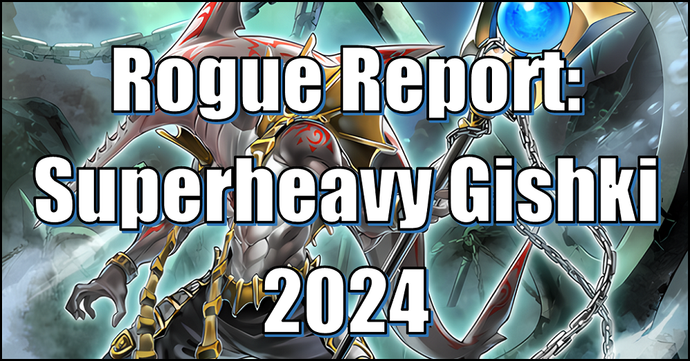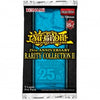Yu-Gi-Oh! Rogue Report: Superheavy Gishki 2024

2024 has been an incredible year for Yugioh so far, with the highest diversity in topping decks we’ve seen in years; in a field where essentially everything can be pushed to viability by way of staple cards, everyone’s going to have a pet deck in the back of their minds. For me, since the release of Cyberstorm Access, that’s been Superheavy Samurai Gishki. I’ve covered this strategy before, here, as it’s something that’s been on my mind for a while — Superheavy Samurai came out of the gate as one of the most dominant combo strategies in years, only to seemingly vanish overnight with the banning of Superheavy Samurai Scarecrow, ruining any pure viability.
Currently, it’s often joked-about as a cheaper alternative to Bonfire, which was released in Maze of Millenia, giving budget duelists access to a Pyro search by way of Infernal Flame Banshee, but I feel it can be so much more. Another strategy that was on the cusp of greatness, only to be snatched away, is Gishki, being the best Spright variant in the OCG for a time, perishing in the TCG at the hand of our Spright Elf ban. Yet, what’s been undiscussed is the potential when combining these two nearly-great strategies, and with the benefit of testing, I’m here to spread the good news. Presenting: Superheavy Gishki 2024.

Let’s first talk about the main concept of the strategy, and why I’ve chosen to pursue such a seemingly peculiar combination. Gishki is currently poised to set up a series of shuffling Monster Negates by way of Evigishki Neremanas, while optioning follow-up in their mainline combo through repeated uses of the non-HOPT Gishki Abyss. Superheavy Samurai provides a Baronne de Fleur in 5 Summons without using the Normal, by way of Superheavy Samurai Prodigy Wakaushi, and sets up a full 1-8 Scale afterwards (though the line has a lot of flexibility depending on opener.
What Gishki needed from Spright in the OCG was a consistent fallback that could insulate their lines, as while Neremanas is an insane capstone, it’s fragile as an opener. What SHS needed from its pure variant was a ceiling, as looping a searcher allowed them to build up resources while retaining an early negate for things like Nibiru. In a broad gamesense, each provides to the other what they had at their highest point, albeit in very different forms. That’s the crux of this choice — taking two potent strategies and commingling them to make up for individual weaknesses.


A quick review of the main lines, for those who want to see what the strategy offers:
- Gishki Grimness, Summon Abyss from Deck, search Gishki Vision, Link into Marincess Coral Anemone, resummon Abyss, search Gishki Shadow, discard both for Gishki Photomirror & Neremanas, Ritual for 4k LP, and resummon either Vision or Shadow to make Worldsea Dragon Zealantis. This line is improved by opening Shadow, as it lets you end on Abyss Dweller, opening Focused Aquamirror, letting you double Neremanas via Aquamirror Illusion, or running Marincess Marbled Rock, or a 2nd Anemone, to loop Abyss once more for a Grimness in hand, or Ritual follow-up. Gishki Nekromirror can be used going second as a removal piece, and Gishki Aquamirror is used when you know you’ll be ending on 2 Neremanas.
- Discard Superheavy Samurai Motorbike, search Wakaushi, Scale Wakaushi, SS & place Superheavy Samurai Monk Big Benkei, who adds Soulgaia Booster. Equip Booster to Wakaushi, SS Booster, Synchro Summon Accel Synchro Stardust Dragon and scale Wakaushi, resummon Bike, make Baronne. Line is improved by opening either Superheavy Samurai Soul card (Booster or Claw), or made worse by opening Wakaushi with no Bike, meaning you go through the Ghoti line (Which searches Grimness for follow-up via Arionpos, Serpent of the Ghoti’s 2nd effect).


A few of the major changes to the list itself from when I last covered it mostly come down to testing, preference, and format. We’re in an incredibly midrangey format, and often the Gishki part of the deck can turn off SHS follow-up. Luckily, going slightly heavier on Level 2s, and the release of S:P Little Knight, solve that issue beautifully. S:P is obviously a good card, but in this deck specifically it allows you to empty your GY of stray S/Ts more readily, meaning we get to play Photomirror to make Grimness a 1-card, something I crucially had to forego last time. Furthermore, now we have Epurrely Plump, which shockingly does a lot for this strategy, and the format. We can strand opposing Rescue-Ace S/Ts, sure, but it can also take either/both of Photomirror and Illusion from our GY in order to ready SHS lines. S:P can even banish our own Benkei, now with 2 copies and 2 targets, to go through Wakaushi twice. This deck is far less all-in than the previous version, and because of that it’s far better positioned.



The Extra Deck is also a lot further ironed-out, as we’ve cut a lot of the fat that held back the prior variant. Now truly low-ceiling hands get access to TY-PHON, and given we’ve cut Icejade Aegirine Ran, we’ve swapped our 2nd Level 10 Synchro to Ruddy Rose Dragon, which empties both GYs. Furthermore, we’re on Plump for edge cases, and 2 S:Ps, brutal on the wallet, to assist in all our card manipulation needs. One other mini-engine in the deck is Ghoti, with a single Maindeck piece in Shif, Fairy of the Ghoti, and two in the extra, being Arionpos & Askaan. This is by far the best thing to do with 6 Levels worth of material here, with a consistently recurring Level 2 Tuner, a SS2 banish, and crucially, searching Grimness. Given it is so low investment, and practically synonymous with SHS at this point, I’ve not even thought to call it out in the deck’s name!
Things we’re not playing, which are up for contention, are things like Superheavy Samurai Ninja Sarutobi, the classic endpoint to a low ceiling Wakaushi opener, or another Marincess monster in the Extra Deck to loop Abyss again. These are both pieces that seem good on paper but don’t actually result in a tremendous gain. An extra Abyss search doesn’t do much when it’s only getting additional Ritual pieces, and if a hand is so bad that it only ends on Sarutobi, it may as well just end on S:P.



In terms of Sidedeck, we’re predominantly on boardbreakers in the form of Gameciel & Lava Golem, with our only real going-first card in the board being Evigishki Gustkraken, letting us weave in a handrip alongside the main line. For Lava Golem specifically, we can actually get away without using our Normal Summon by Pendulum Summoning the initial Grimness, in best-cast hands. We’re also on Veiler alongside Ghost Mourner & Moonlit Chill, as targeted negation given Imperm isn’t an option.
This deck does get to play a significant portion of Maindeck nonengine though, and we’re using it for a swath of powerful cards. Starting off with Ash & Droll, these are the two main ‘must-have’ handtraps in this format, but I’m also playing 2 copies of Ghost Belle & Haunted Mansion in the main, as I feel it does enough to stop decks that often can slip past targeted negation. Finally, 2 copies of Kashtira Fenrir are here, simply as ‘good cards’. I was on a third for a long time, but space is truly very tight.
Not only have I learned a lot about this strategy from the time I last covered it, my gamesense has improved demonstrably. This is a deck that rewards sequencing, as each engine has the chance to lock the other out, and only by properly timing your pieces will you come out ahead. In terms of matchup spread, there’s actually not a lot to complain about; you’re a midrange deck that gets to play two fantastic strategies in one, and the only real caveat is that taking over 1000 damage can lock you out of a few lines (Given Photomirror costs 4k, and Nekromirror 3k); Swordsoul is the obvious natural predator, and while it’s good, it’s not especially popular as of writing this. The Sidedeck, and to some extent the Extra, are up for debate, but overall I’d wager we’re nearing a version of this deck I would call ‘finished’. I can’t wait to play it more in paper, and even experiment with a version on Master Duel!

I fully intend to have a big year of paper play with Yugioh this year, and this strategy is just what I was needing. I did mention last week that I’d be covering the Earthbound Servants, but I didn’t feel I found anything of quality to show off after testing; the closest thing was a P.U.N.K. pile, but that didn’t end up working.
That said, I hope you enjoyed this look into Superheavy Gishki! This sort of strategy is exactly why I love Yugioh, and why diverse formats like the one we’re currently in are amazing. I look forward to tuning this pile as I become even more adept! If you have any suggestions or questions about my deck this week, let me know in the comments below!










